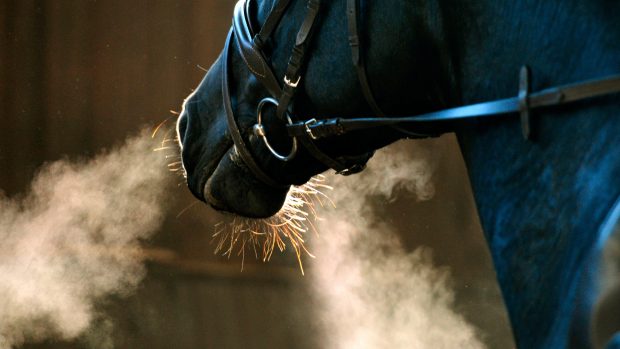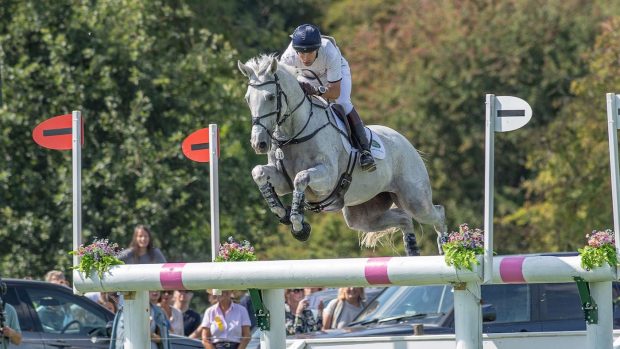The horse’s larynx or “voicebox” is situated at the back of the throat and hasseveral important functions. It is at the crossroads between the respiratory system and the digestive passages and also has a role to play in vocalisation.
Just in front of the larynx is the soft palate, which is an extension of the roof of the mouth. Boluses (balls) of food are formed below the soft palate and above it is the horse’s airway.
For the majority of the time, the larynx is locked into this part of the airway with an airtight seal. During each breath, air moves from thenose, through the nasal chambers, over the soft palate and through the larynx into the windpipe.
This means that, at exercise, the horse must breathe through its nose and the positioning of the healthy larynx provides excellent streamlining of the airway, so that there is minimal disruption to the smooth flow of air and breathing is efficient.
In contrast, when the horse is eating and swallows food, the airtight seal is broken momentarily. The soft palate flips upwards to block offthe back of the nose and prevent the return of food through the nostrils.
The larynx closes to prevent food entering the windpipe which then allows food to pass down the gullet. If food enters the windpipe accidentally, it causes irritation andmakes the horse cough.
Diseases affecting the airway
The most common disease of the larynx is laryngeal paralysis due to a recurrent laryngeal neuropathy or paralysed nerve. Affected horses are often referred to as whistlers or roarers. A respiratory noise is caused by a disruption to the smooth flow of air along the respiratory route into the windpipe.
Recurrent laryngeal neuropathy is a disease which affects the recurrent laryngeal nerve and causes it to function poorly or not at all.
The healthy nerve energises a muscle on the larynx, making that side of the larynx open. If the nerve is diseased, it causes one side of the larynx (almost always the left side) to become weak or, in severe cases, completely paralysed.
This means that part of the larynx is not pulled open, tissue hangs down, obstructing the airway, and the sacule (a small opening on the side of the larynx) sags open.
Noise is generated at exercise when the horse breathes faster and air passes through the partly closed larynx and across the entrance of the open sacule. The air becomes turbulent, producing a whistling sound.
In addition to the respiratory noise, this disease also affects the amount of oxygen the horsegets into its lungs and, therefore, his bloodstream. The reduced oxygen intake diminishes the horse’s athletic performance.
Recurrent laryngeal neuropathy is thought by some to be an inherited disease and horses of more than 16hh are most susceptible. It is increasingly rare in horses under 15.2hh. This is because, in bigger horses the affected nerve is longer, making it more likely to function badly. The condition is often noticed once faster exercise starts, quite soon after the horseis broken in.
Solving breathing problems
The Hobday is a straightforward operation, which involves entering the larynx from underneath the throat and removing the sacule which is causing the turbulent air at exercise.
The vocal cord adjacent to the sacule is also often removed. This operation reduces the amount of respiratory noise produced at exercise but does not dramatically increase the amount of oxygen the horse obtains with each breath and so may have little effect on performance.
Another commonly performed operation is the tie-back. This involves placing a large suture on the affected side of the larynx to hold it in a permanently “open” position. The end result is improved oxygen uptake at exercise and,therefore, improved performance, but complications can arise.
The larynx is held permanently open and food can enter the windpipe causing coughing. Another problem is when the suture breaks, or pulls through, and the larynx loses its open position.
Affected horses
Horses performing only relatively light work such as quiet hacking don’t require high levels of oxygen so appear unaffected by laryngeal paralysis.
Show jumpers and dressage horses perform with maximum effort for relatively short periods of time and are not often required to perform fast work, so a degree of laryngeal paralysis can be quite easily tolerated.
Event horses manage much less well with any laryngeal paralysis once they have to attainfaster times on the cross-country phase. Any horse with poor laryngeal function will perform better if it is fitter than a normal horse would need to be to perform the required activity.



